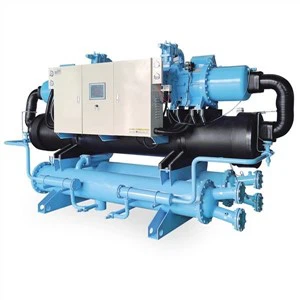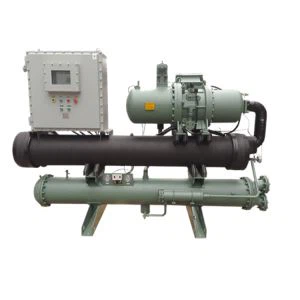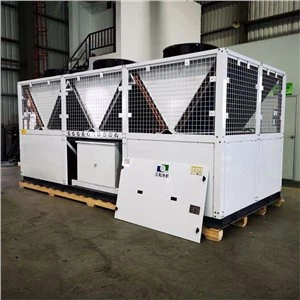As a seasoned supplier of air - cooled screw chillers, I understand the pivotal role that performance curves play in the decision - making process for our clients. These curves are not just a bunch of lines on a graph; they are a treasure trove of information that can help users understand how well a chiller will perform under different conditions. In this blog, I'll guide you through the process of reading and interpreting the performance curves of an air - cooled screw chiller.
Understanding the Basics of Performance Curves
Before delving into the details, it's essential to know what performance curves represent. In simple terms, they are graphical representations that show the relationship between various operating parameters of an air - cooled screw chiller. The most common parameters include cooling capacity, power consumption, and coefficient of performance (COP) as functions of entering condenser air temperature and leaving chilled water temperature.
The x - axis of the curve usually represents the entering condenser air temperature, which is the temperature of the air that enters the chiller's condenser. The y - axis can represent different variables such as cooling capacity, power consumption, or COP. Each curve on the graph corresponds to a specific leaving chilled water temperature.
Reading the Cooling Capacity Curve
The cooling capacity curve is perhaps the most critical one for users. It shows how much cooling the chiller can provide at different combinations of entering condenser air temperature and leaving chilled water temperature.
When looking at the cooling capacity curve, you'll notice that as the entering condenser air temperature increases, the cooling capacity of the chiller decreases. This is because higher air temperatures make it more difficult for the condenser to reject heat, reducing the overall efficiency of the chiller. On the other hand, as the leaving chilled water temperature increases, the cooling capacity generally increases.
For example, if you have a process that requires a constant leaving chilled water temperature of 7°C, you can use the curve to determine how the cooling capacity will change as the outside air temperature fluctuates. If the outside air temperature rises from 30°C to 40°C, you'll see a significant drop in the cooling capacity. This information is crucial for sizing the chiller correctly to ensure that it can meet the cooling demands even under the hottest conditions.


Interpreting the Power Consumption Curve
The power consumption curve shows how much electrical power the chiller consumes at different operating conditions. Similar to the cooling capacity curve, the power consumption is also affected by the entering condenser air temperature and the leaving chilled water temperature.
As the entering condenser air temperature increases, the power consumption of the chiller also increases. This is because the compressor has to work harder to reject the heat when the outside air is warmer. Additionally, as the leaving chilled water temperature decreases, the power consumption generally increases because the chiller has to remove more heat from the water to achieve a lower temperature.
Understanding the power consumption curve is important for estimating the operating costs of the chiller. By analyzing this curve, you can determine the most energy - efficient operating conditions. For instance, if you can tolerate a slightly higher leaving chilled water temperature, you may be able to reduce the power consumption significantly.
Analyzing the Coefficient of Performance (COP) Curve
The COP is a measure of the chiller's efficiency, defined as the ratio of the cooling capacity to the power consumption. The COP curve shows how the efficiency of the chiller changes with different operating conditions.
A higher COP indicates a more efficient chiller. Generally, the COP is highest at lower entering condenser air temperatures and higher leaving chilled water temperatures. This means that the chiller operates most efficiently when the outside air is cool and the required chilled water temperature is relatively high.
When comparing different air - cooled screw chillers, the COP curve can be a valuable tool. You can choose a chiller that has a higher COP over the range of operating conditions that are most relevant to your application. This will not only reduce your energy costs but also have a positive impact on the environment.
Practical Applications of Performance Curves
Performance curves are not just theoretical concepts; they have real - world applications. For example, in the pharmaceutical industry, precise temperature control is crucial. By using the performance curves of an Air Cooled Screw Chiller for Pharmaceutical Industry, manufacturers can ensure that the chiller can maintain the required temperature for storing and processing medications.
In the plastic extrusion industry, the cooling process affects the quality of the final product. The Industry Screw Chiller for Plastic Extrusion performance curves can help operators optimize the chiller's operation to achieve the best results.
For machine tool applications, where overheating can damage the equipment, the Air Cooed Chillers for Machine Tool performance curves can be used to select the right chiller and ensure its reliable operation.
Factors Affecting Performance Curves
It's important to note that the performance curves provided by the manufacturer are based on standard test conditions. In real - world applications, several factors can affect the actual performance of the chiller.
One of the main factors is the fouling of the condenser and evaporator coils. Over time, dirt, dust, and other contaminants can accumulate on the coils, reducing the heat transfer efficiency. This can cause the cooling capacity to decrease and the power consumption to increase. Regular maintenance, including cleaning the coils, is essential to ensure that the chiller operates close to its rated performance.
Another factor is the refrigerant charge. If the refrigerant charge is too low or too high, it can affect the chiller's performance. A low refrigerant charge can lead to reduced cooling capacity, while an over - charged system can cause higher power consumption and potential damage to the compressor.
Conclusion
Reading and interpreting the performance curves of an air - cooled screw chiller is a skill that can help you make informed decisions when selecting and operating a chiller. By understanding these curves, you can ensure that the chiller meets your cooling requirements, operates efficiently, and has a long service life.
If you're in the market for an air - cooled screw chiller or need more information about how to optimize your existing chiller's performance, don't hesitate to reach out. We're here to assist you in finding the best solution for your specific needs. Whether you're in the pharmaceutical, plastic extrusion, or machine tool industry, we have the expertise and the right products to meet your demands. Contact us today to start the procurement and negotiation process.
References
- ASHRAE Handbook of Refrigeration.
- Manufacturer's technical documentation for air - cooled screw chillers.






